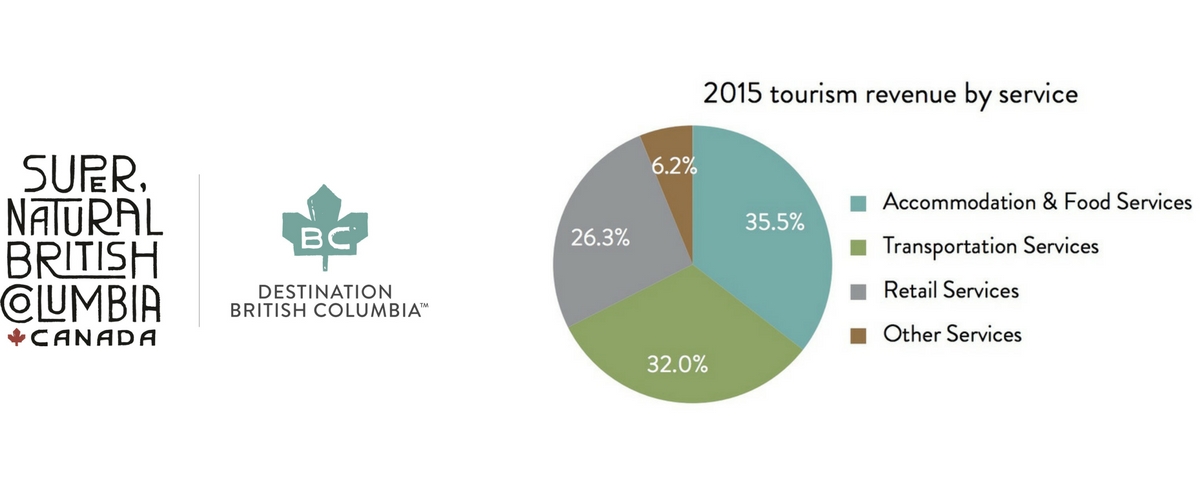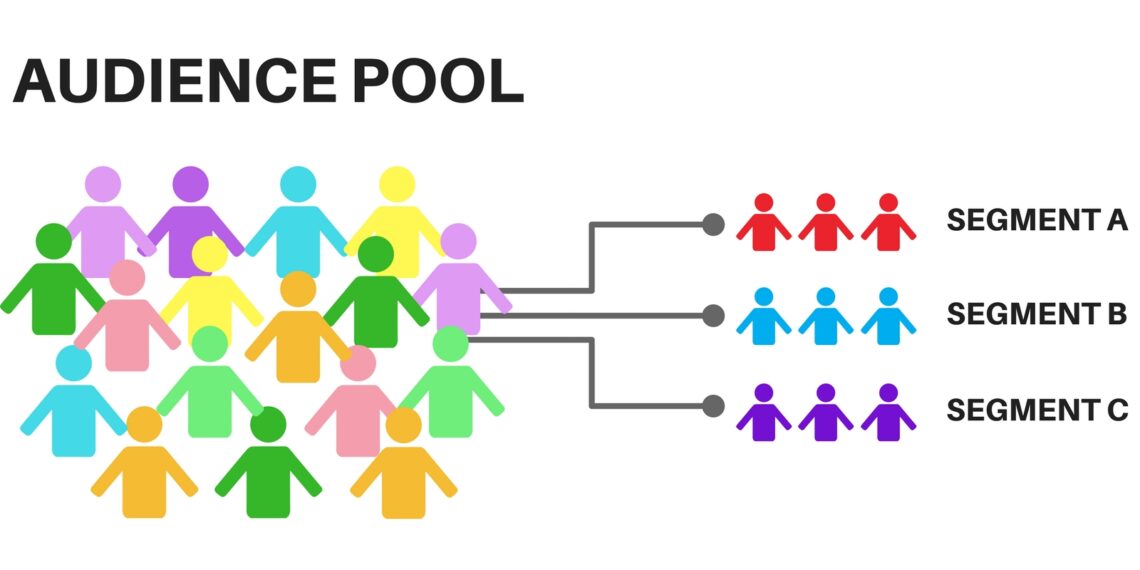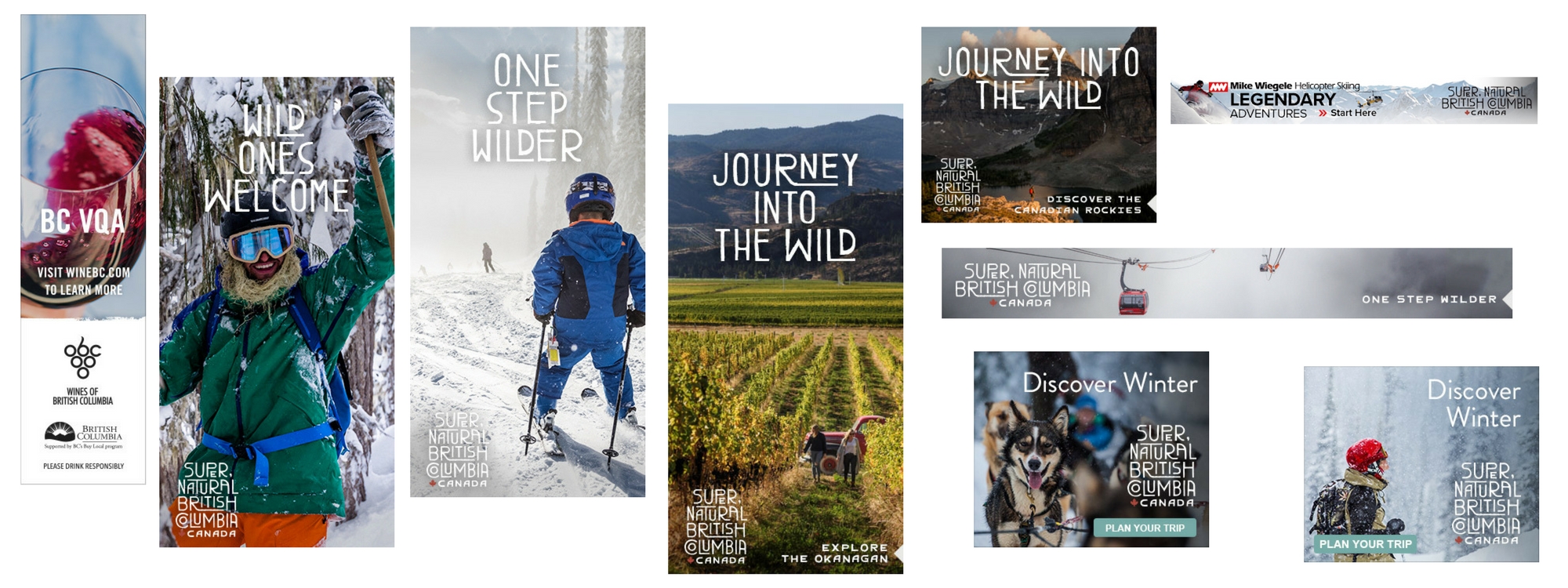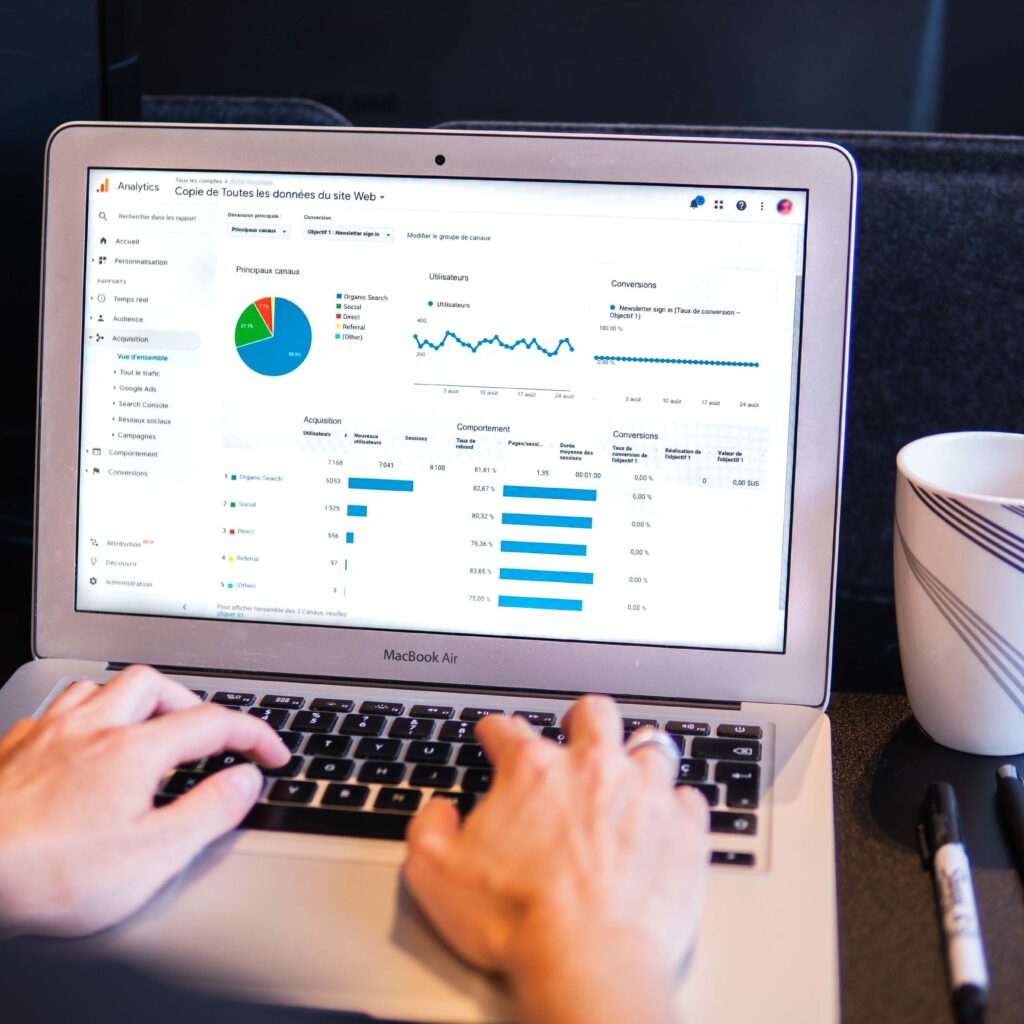Destination BC and the Website Tagging Initiative
Post Contents:
- Introduction
- Building a Powerful Marketing Network
- Website Tagging Overview
- What happens when a Floodlight Tag is added?
- What kind of information is collected?
- Conclusion
Introduction
The tourism industry in British Columbia is undergoing some pretty radical change.
In 2015, the tourism industry generated $15.7 billion in revenue, a 5.3% increase over 2014, and a 37.3% increase from 2005. The tourism industry contributed $7.4 billion of value added to the BC economy, as measured by GDP (in 2007 constant dollars). This represents 5.6% growth over 2014 and 17.5% growth since 2007. British Columbia has always been a world-class destination, and now the world is really starting to notice.

In addition to industry growth, we’re seeing an unprecedented change in technology. This is largely driven by the growing utility of the internet, emerging applications, and smartphone technology. How people find information before making a decision has changed so dramatically that businesses struggle to understand and keep up.
I see this first-hand at Navigator working with DMO’s, hoteliers, wineries, and tour operators across the province. Businesses are allocating more resources to their online presence in website/ecommerce, social media, digital advertising channels, and analytics. And this isn’t just in tourism; we are seeing a transfer of advertising spend from traditional media into digital, as all businesses adjust into this new medium.
BC Tourism is adopting new technology to better understand what motivates people to travel to BC. This requires the implementation of technology like DMP‘s, website tagging, and working with companies like Google and Facebook to collect data on anyone who qualifies as a potential tourist in BC. By collecting this information, datasets become more reliable and BC Tourism can market more efficiently.
I had a phone call in early February with Richard Bergen, Marketing Manager, Strategy and Channel Integration at Destination British Columbia. It was an interview-style 50-minute discussion on DBC’s tagging initiative and what this means for BC Tourism. I had seen a couple of DBC tagging presentations, installed the tag myself a couple of times, and knew about their pilot project from the 2016/17 ski season. But I was still left with some unanswered questions and thought it would be best to set the record straight with a phone call to DBC directly.
Destination British Columbia takes the lead role in tourism development, management and marketing programs in key domestic and international markets, working closely with private sector operators and industry groups and other government ministries to create an integrated approach in B.C. It is Destination British Columbia’s role to increase demand for all tourism products and regions of B.C., for the benefit of the entire industry.
Building a Powerful Marketing Network
If you work in tourism, you’ve likely already heard of DBC’s tagging initiative or the 2016/17 Ski Campaign Tagging Pilot.
Why is this important? We know building an infrastructure to “map” all the interactions or touchpoints a tourist has throughout their buyer journey is valuable. But what are some of the use cases?
With the exception of some stakeholder role overlap and timeline, the table below identifies 4 key stages in the tourism journey. DBC has a fascinating challenge in reaching a large audience in a personalized way. By collecting data at the DMO or local business level, they can gain insight from these sources to target new people who may not have ever thought of traveling to BC, but closely fit the profile of those who do.
| Stakeholder | Timeline | Tourist Detail |
| DBC | 6-10 months from travel date | If you want to plan a summer vacation for your family, you might start by asking colleagues or friends if they have any recommendations. It’s also possible that the location is less important, but you’re seeking a specific activity, like camping or a wine tour. Or maybe your search begins broader, and your looking for ideas and inspiration on your next trip. |
| DMO | 2-6 months from travel date | Once you’ve decided on your destination, the itinerary planning begins as you look for more specific activities, places to eat, and stay. |
| Local Business | Trip Experience | During your stay, you might look up information on a trail map, or local events happening that weekend. |
| Local Business | Post Trip Experience | You return from your trip, share your experience with friends and family on Facebook or Instagram. |
Data Segmentation
Our mobile devices and search engines play an important role in every part of the tourist journey. Mobile and search and “micro-moments” are still a new search behavior. Based on how the tourist uses search, Google will refer to sites like helloBC, a local DMO, hotel or tour operator website, TripAdvisor, Facebook and Instagram, Travel Blogs, and more.
All of these “digital touchpoints” have influence over how we make decisions. And because everyone is so different, knowing what one individual does online to book a trip is not very useful.
However, collecting data on groups of people over time becomes very useful. By segmenting data by age, or geography, or a conversion goal, we could then learn to create more useful content that is more personalized. We could then see trends in how people are using technology or websites differently, allowing more efficient allocation of the budget into programs that need it most.

Basic Segmentation Example:
- A website is tagged and collects data on all website visitors.
- The website converts on average 1% of all website traffic.
- By creating a segment on converted website visits, you learn that iPhone users between 24-35 in Vancouver convert at 4x the website average, at 4%.
By segmenting your data you can identify groups of people that complete website objectives at a higher rate than the website average. This can be used to design ad creative, and targeting around these high-value audience groups.
This is an ambitious undertaking
Tagging 100% of the participating websites still leaves an incomplete picture on the digital tourist journey. These are some of the attribution challenges faced with consideration to the technology, and how people interact online.
Cookie-based Tracking:
There is a percent of the population that use an ad blocker or private browsing that would exempt them from this list. Cookies also have an expiry.
Cross-device Tracking:
An increasing number of us have smartphones, tablets, and computers. Using multiple devices can make it more challenging for Google or 3rd parties to attribute unique and returning sessions when one unique user is using multiple devices.
3rd-party Websites:
This is especially true for websites that facilitate a transaction. Websites like Airbnb and Uber are rapidly growing as part of the tourism experience. Online Travel Agency (OTA) websites like booking.com or Expedia play a significant role in the buyer journey for many tourists. Websites that don’t take a transaction like a news article or travel blog are also in this group.
Social Media / Dark Social:
Social Media likes, follows, hashtag use and content quality does have an influence on making a destination more desirable, but it’s difficult to know by how much.
Tagging Stakeholders:
- Destination British Columbia (DBC)
- Destination Marketing Organizations (DMO)
- Tourism Partners/businesses
DBC wants validation that their marketing efforts are working, and make changes when things aren’t. This is done by tracking “referrals” and “conversions” that take place on local stakeholder websites.
- Referral conversion tag
This tag will fire (activate) when there is traffic to a stakeholder website that has landed on the DBC website at some point along the way. - Sales conversion tag
This tag will fire only when a transaction has been made, like a booking from a hotel. This tag would be placed on the payment confirmation page or thank-you page after the transaction is complete.
This is their way of measuring attribution. Over time, DBC can learn more about the type of person that achieves these conversions to improve their targeting or ad creative.
DBC will also be able to build “audience pools” which is very similar to how remarketing lists work. These audience pools may span beyond people who have been on a business website or business listing on the DBC website. They allow for segmented targeting into your business category (eg. “Anyone who has been to a ski hill website in the Kootenays but lives in Seattle” could be in an audience pool). These pools are very flexible and can be narrowed down based on particular business needs.
These audience pools can be used for any ad platform. Google’s ad platform (DoubleClick, AdWords) accounts for Display ads, YouTube video ads, Search ads and remarketing. DBC will be able to run their own remarketing ads (through DoubleClick, which is Google’s programmatic display platform for larger spend accounts).
So in the example of the Ski Hill pilot, DBC tagged a number of ski hills, then off of their participants’ site traffic, built up their audience pools. Then DBC took this collective (anonymous 3rd party) site traffic and was able to run display ads against that audience, or use this cookied audience pool to create similar “lookalike” audiences.

Website Tagging Overview
Businesses in the tourism industry will “tag” their website(s) with snippets of code to track broad or very specific user interactions on their website.
The most common website tag is Google Analytics. A snippet of code that is placed in the head on every page of a website. The default install of Google Analytics will allow a business to run reports on where traffic is coming from, how they are using the website, and more.
Google Analytics can be used in more advanced configurations to track specific events like button clicks, form submits, and e-commerce transactions. These valuable interactions are defined as goals, and businesses can use this data to learn more about the who/what/when/where parts of there customers to influence their marketing decisions and optimization.
Over time this data becomes even more useful as you can report on year-over-year trends, seasonality, and find opportunities for improvement.
Google Analytics will collect non-personally identifiable information such as:
- Location (city)
- Device (mobile/tablet/desktop)
- Traffic source (Organic Search/Social/Website referral)
- New or returning session
- Age/Gender
- Affinity and Interests
Google Analytics Snippet Example:
<!-- Global site tag (gtag.js) - Google Analytics -->
<script async src="http://www.googletagmanager.com/gtag/js?id=UA-XXXXXXXX-1"></script>
<script>
window.dataLayer = window.dataLayer || [];
function gtag(){dataLayer.push(arguments);}
gtag('js', new Date());
gtag('config', 'UA-XXXXXXXX-1');
</script>
Facebook has a tracking tag, called the Facebook Pixel. Businesses will typically add this tag to every page on their website, allowing them to gather audience insight for Facebook advertising. This is valuable for any business size, and Facebook offers an impressive amount of targeting parameters to either broaden or narrow down your audience.
Facebook Pixel Snippet Example:
<!-- Facebook Pixel Code -->
<script>
!function(f,b,e,v,n,t,s){if(f.fbq)return;n=f.fbq=function(){n.callMethod?
n.callMethod.apply(n,arguments):n.queue.push(arguments)};if(!f._fbq)f._fbq=n;
n.push=n;n.loaded=!0;n.version='2.0';n.queue=[];t=b.createElement(e);t.async=!0;
t.src=v;s=b.getElementsByTagName(e)[0];s.parentNode.insertBefore(t,s)}(window,
document,'script','http://connect.facebook.net/en_US/fbevents.js');
fbq('init', 'XXXXXXXXXXXXXXXX'); // Insert your pixel ID here.
fbq('track', 'PageView');
</script>
<noscript><img height="1" width="1" style="display:none" src="http://www.facebook.com/tr?id=XXXXXXXXXXXXXXXX&ev=PageView&noscript=1" /></noscript>
<!-- DO NOT MODIFY -->
<!-- End Facebook Pixel Code -->
Destination BC is using a Floodlight Tag, technology provided by DoubleClick (Google). This tag looks and behaves similarly to the Facebook Pixel and Google Analytics.
Google Floodlight Tag Snippet Example:
<iframe src="http://1234567.fls.doubleclick.net/activityi;src=1234567;type=abcde123;cat=fghij456;u1=[friendlyname1];u2=[friendlyname2];ord=[Random Number]?" width="1" height="1" frameborder="0" style="display:none"></iframe>
Note: It’s important to disclose what information is collected and how it is used on your websites privacy policy.
Bonus: Google Tag Manager
With so many tags added to a website, it can get challenging to keep track of which ones you have. If you need to update or change these tags it can be a bit of a hassle engaging more technical people to make these tag updates on your behalf. Google created Google Tag Manager (GTM) to allow multiple tags like Google Analytics, Facebook Pixel, Floodlight tags and more to be added and managed from one place, and only one “container tag” would need to be added to your website.
This makes tag management easy and organized (when done right), especially when agencies or other 3rd parties are marketing or working on a website. Google offers user management with Google Tag Manager, similar to how Google Analytics to make it easy to add/edit/remove user access.
What happens when a Floodlight Tag is added to a website?
The website itself won’t change, but the tag will perform a specific action. When the user loads a web page that the tag exists on, it may send information back to the 3rd party (in this case DBC). There are certain rules that apply to the tag in order for it to “fire” or send this information.
For example, a standard Google Analytic tag will be added to every page on a website, and fire once on each pageview. So when a user visits the website Google Analytics will track (most) interactions that the user has with the site in a given session.
Interactions like button clicks, goal tracking, e-commerce transactions can all be set up using the same Google Analytics tag, but these custom interactions must be set by the Analytics admin or person managing the website.
The same rules apply to DBC’s Floodlight tag, where DBC will be collecting session information, but a “conversion” will only take place if certain parameters are met:
Example 1
- UserA visits hellobc.com
- UserA visits skifernie.com (this website has been tagged)
- Tag fires and DBC reports on their referral (conversion goal)
Note: No advertising has taken place here, all organic interactions. In this scenario, DBC is able to quantify their value in terms of organic referrals.
Example 2
- UserB is in a DBC audience pool based on their interests and demographics
- DBC runs a display ad campaign targeting the audience pool that UserB is in
- UserB sees DBC display ad, clicks the ad
- User B is taken to skifernie.com, tag fires, and DBC reports on their referral (conversion goal)
Example 3
- UserC is in a DBC audience pool based on their interests and demographics
- DBC runs a display ad campaign targeting the audience pool that UserC is in
- UserC sees DBC display ad 8 times over 2 weeks, but never click the ad
- UserC makes a Google Search and clicks through to the skifernie.com website
- User B is taken to skifernie.com, tag fires, and DBC reports on their referral (view through conversion goal)
Audience Pools and Conversion Attribution
Referring to the 3 examples above, how far back in the buyer journey might DBC look for conversion attribution on their campaigns? There are a few considerations with the amount of time that is elapsed from someone’s first exposure to an ad.
Remarketing data shows that the probability of someone engaging with an ad or taking action decreases over time. Therefore it makes sense to prioritize recency by running campaigns against those who have already interest.
We do use a 90-day attribution model as it’s the strongest model we have available to accurately determine what media influenced users to take action (longer than 90 days and the model can’t handle all the data coming in). Audience pools however can last much longer, and are not beholden to the attribution model for their duration. In fact, we either have or will soon be adjusting our audience pool duration to last up to 9 months.
The value of these longer-lasting audiences is greatly diminished over time – cookies are wiped out, behaviours and intentions change over time and we would need to constantly update profiles and cookie details – but working on a longer purchase cycle of travel and tourism, we think it’s the better path to take.
So, retargeting a user can be done as long as the cookie exists on their web browser, which will be a 9 month model in the future. This also helps us collaborate and share segments with other partners in the future. We won’t want to bombard someone for 9 months ourselves, but we may want to pass them down to lower funnel partners, much like your stakeholder table described.
What kind of information is collected?
For Google, the short answer, quite a bit.
google.com/policies/privacy/#infocollect
If you use any of Google’s services like:
- YouTube
- Gmail
- Google Chrome
- Google Search
- Google Maps
- Google Drive
Then you will likely have a Google Account. Your google account has profile criteria like age, gender, location, occupation, and more (optional). If you’re browsing the web while signed into your Google Account, Google is able to infer different affinities or interests. For example, if you watch a youtube video on how to fix a specific car, or visit a lot of gluten-free recipe websites. Over time Google is able to learn quite a bit from their users both explicit and implicit.
As an advertiser using Google ad services (DoubleClick), DBC is able to create segmented “lookalike” audiences based off of their tagged audience pools. Then DBC can maintain a degree of targeting relevance and reach new people at a much larger scale that fit their current user profile.
These “lookalike” or similar audiences then engage with ads at a higher rate and are more likely to convert allowing DBC to make better use of advertising spend.
Both Google and DBC stress that the user information collected is anonymous, and used in aggregate. This means that non-personally identifiable information is collected, and when the data is being analyzed it can be segmented but not down to the specific user.
Conclusion
On one hand, Destination BC wants a clearer picture of their own marketing attribution and remarketing is the best-fit ad product for them to achieve the lowest cost-per-conversion. The decisions made from the data collected will be outside of DMO or local business control, and small business will likely find higher value in using their own Facebook Pixel and Google Remarketing tags for advertising.
However, DBC’s role in the marketing relationship is to drive demand and awareness, not necessarily sales and conversions. Their conversion tags seek to answer the “who is our customer” question, then use that insight to reach more of those customer’s at scale through programmatic digital advertising. This will fill the top part of the funnel with more qualified interest, which will benefit every stakeholder in BC tourism.
Business owner’s operating in BC’s Tourism Industry are apart of a growing industry where some of our biggest problems are labour shortages. The pace of change is so fast in the online world that it can be hard to make quick decisions or trust you’re doing the right thing. I don’t think this pace of change will slow down anytime soon, which is why strategic partnerships are so valuable to be competitive. This applies to the small business all the way up to the provincial level. It’s inspiring to see some technology leaders in the industry rethink content marketing and see the rise of organized engagement on social media.
It’s this type of collaborative network and willingness to innovate is what’s needed to set our province apart and drive visitation.
Thank you for reading this and if you have any questions or comments please leave one below or email me scott@navigatormm.com.
Links/sources:
http://www.destinationbc.ca/Marketing/Consumer-Marketing/Tagging.aspx
http://www.destinationbc.ca/BC-Tourism-Industry/Overview-of-Tourism-in-B-C.aspx
http://www.destinationbc.ca/getattachment/Marketing/Consumer-Marketing/Tagging/Case-Study-on-Tagging-Pilot-Marketing.pdf.aspx
http://www.destinationbc.ca/cmspages/getfile.aspx?guid=55651809-3ab6-4f0e-ba36-9bffb8de7ef9
http://www2.gov.bc.ca/gov/content/data/statistics/business-industry-trade/industry/tourism
http://moat.com/advertiser/super-natural-british-columbia
http://blog.hootsuite.com/dark-social/
http://www.google.com/policies/privacy/
http://www.recode.net/2017/7/19/15949782/airbnb-100-million-stays-2017-threat-business-hotel-industry
http://www.magnaglobal.com/wp-content/uploads/2017/12/121117-MAGNA-Global-Forecast_Winter-Update_Final.pdf
http://digiday.com/media/what-is-a-dmp-data-management-platform/
http://www.go2hr.ca/sites/default/files/legacy/reports/go2HR-2016-Tourism-Labour-Shortage-Economic-Impact-Study.pdf
Destination BC Tag Team:
Sean McDonald
Sean.McDonald@DestinationBC.ca
Richard Bergen
Richard.Bergen@DestinationBC.ca


